Want a small tree with beautiful delicate flowers to spruce up your landscape? You need to get yourself a Lily Magnolia!
Magnolia LiLiiflora is also commonly known as Lily Magnolia. It is a beautiful large shrub or small tree that will make a great addition to any landscape. Lily Magnolia is one of the smaller species belonging to the Magnolia genus. So this shrub is perfect for small gardens that need an elegant focal point. A Magnolia LiLiiflora will also make a lovely addition to landscapes in city gardens or cottage gardens.
If you’ve ever seen Lily Magnolias in bloom, you already know how easily they capture your attention. Their huge spread of green leaves and delicate flowers make Magnolia trees very popular.
Native to southwestern China, the Lily Magnolia trees that first arrived in English-speaking countries were cultivated in Japan. For this reason, in certain places, people refer to Magnolia shrubs as Japanese Magnolias.
From late winter to early spring, Lily Magnolia produces beautiful blooms. These shrubs can make spectacular shows in any landscape, be it rural or urban.
Ready to learn more about how to grow and care for Lily Magnolia? Keep reading below!
Quick Facts
| Fact Category | Details |
|---|---|
| Common Name | Lily Magnolia, Japanese Magnolia |
| Scientific Name | Magnolia Liliiflora |
| Origin | Southwestern China |
| Growth Height | 8 to 12 feet (2.43- 3.65 m) |
| Flower Color | Dark reddish-purple |
| Blooming Time | Late winter to early spring |
| Sunlight Requirements | Full sun or partial shade |
| Soil Requirements | Well-draining, slightly acidic soil |
| Cold Hardiness | Down to -10 °F (-23.3 °C) |
| Propagation | By cuttings or seeds |
| Common Pests/Diseases | Phytophthora, Scale insects, Coral spot, Honey fungus |
| Toxicity | Non-toxic to humans and pets, but not edible |
About Lily Magnolia
- Magnolia LiLiiflora belongs to the family of Magnoliaceae, and it is native to southwestern China.
- People have cultivated this mesmerizing tree for many centuries in parts of China and Japan.
- Other common names of this shrub include Purple Lily Magnolia, Mulan Magnolia, Purple Magnolia, Tulip Magnolia, Jane Magnolia, and Woody Orchid.
- Thanks to being a small tree with wonderful foliage and elegant flowers, Lily Magnolia looks great in any small garden landscape.
- Some great garden early spring-flowering companions for Lily Magnolia include Camellias, Bulbs, Calla lilies, and a mix of ferns and hostas. All these early spring-flowering plants will adjust to the partial shade underneath your Lily Magnolia and bloom at the same time with the tree.
- This shrub can be somehow temperamental when it comes to environmental conditions. It really needs ideal growing conditions to thrive. However, as long as you give it what it needs, it will grow into a lovely and majestic small tree.
- Lily Magnolia is sun-loving. This shrub prefers sunny spots where it can get full sun but it can also adapt to partial shade.
- It’s best to provide your Lily Magnolia with as much sun as possible for the best flowering.
- Lily Magnolia is pretty cold-hardy, and it can survive temperatures down to -10 °F (-23.3 °C). So, it is best to plant it in an area of your garden where it will be safe and won’t suffer damage due to strong winds and very cold temperatures.
- Pay attention to protecting your Lily Magnolia from early spring cold spells as its spring flowers can easily fall off due to freezing temperatures.
- It is best to grow this shrub in consistently moist, slightly acidic soil. You need to make sure that you provide your Lily Magnolia with well-draining soil as it is sensitive to root rot. Water this small tree regularly throughout the year.
- Magnolias are relatively problem-free shrubs. The tricky part is that their problems can be life-threatening. Some of the known dangers to Lily Magnolia besides phytophthora include scale insects, coral spot, and honey fungus.
- Keep an eye out for these problems because they might not kill the plant, but they can definitely affect its appearance. So, if you identify any of these problems, treat them immediately.
- Magnolia tree is not toxic for humans or pets if they handle it or ingest it. It is not edible, so no one should ingest it. But if it happens by accident, you don’t have to worry about poisoning or other extreme reactions.
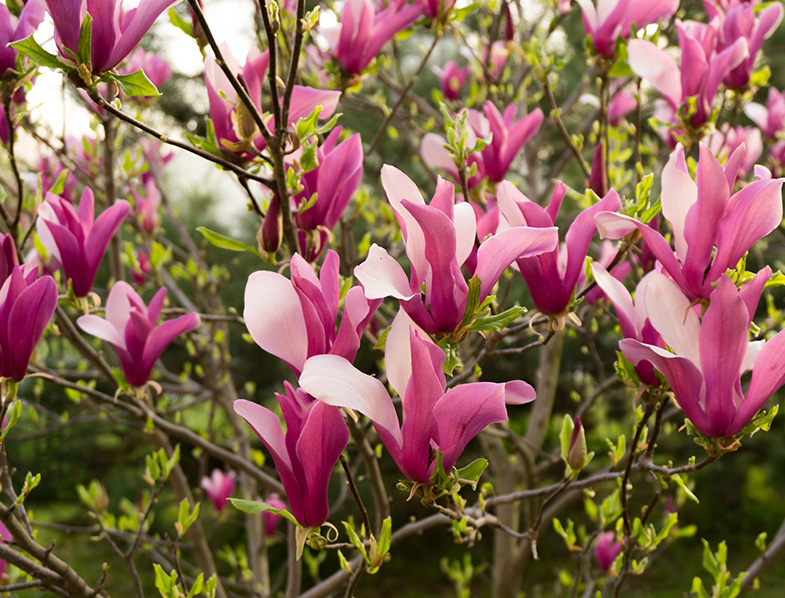
Lily Magnolia Features: An Overview
- Lily Magnolia grows as a large shrub, or small tree branching from the base. This species is one of the smallest found in the Magnolia genus, which is why people with small gardens prefer it.
- If you grow it from seed, it can take a Lily Magnolia up to 10-15 years to reach maturity. This shrub can reach heights of 8 to 12 feet (2,43- 3,65 m).
- It features deep lustrous green leaves on its branches and, in early spring, it produces slightly fragrant, dark reddish-purple flowers. The flowering can continue for the rest of the summer.
- Lily Magnolias produce flowers that are tulip-shaped and that have 9 to 18 tepals.
- The blooms of Lily Magnolias can be up to 5 inches (12 cm) long.
Growing Lily Magnolia
Some gardeners consider that Lily Magnolia is a little bit temperamental when it comes to growing conditions. But the good news is that it’s really not impossible to grow and care for this shrub. All it takes for Magnolia LiLiiflora to thrive is a gardener who can pay attention to the ideal growing conditions and who keeps an eye out for problems and pests. In return, this shrub will repay you by being an elegant and lovely focal point in your landscape.
First, let’s talk about Lily Magnolias’ lighting requirements. As we’ve mentioned above, this mesmerizing shrub is sun-loving and needs full sun conditions for best blooming. It can also adapt to partial shade if necessary. However, we highly recommend finding a spot in your garden where the small tree will get at least 4 to 6 hours of sunlight per day for best flowering.
- The Lily Magnolia is a very ornamental shrub to small tree originally from China.
- Sow 1/2" deep in pots with moistened seed-starting mix. Place in warm indirect sunlight and keep soil moist. Germination will occur in 4-6 weeks.
- Pour warm water over seeds and soak for 24 hours. Wrap seeds in a paper towel soaked with 1 part peroxide/5 parts water. Keep moist in ziplock bag and cold-stratify in fridge or cold-frame for 8 weeks.
- The Lily Magnolia has a long bloom time, & can bloom again or all the way through fall in warmer climates!
- Fresh Clean Seeds
- Plant seeds: Fall / Cold Stratify / Indoors weeks before last frost
- The huge 3¡± fragrant flowers absolutely smother the plant perfuming the air.
- light requirements: full sun to part shade
- number of pieces: 15
Last update on 2024-09-28 / Affiliate links / Images from Amazon Product Advertising API
When you first plant your Lily Magnolia, you don’t have to apply any fertilizer. Afterward, your shrub will definitely benefit from a spring feeding with a slow-release fertilizer. It will give your Lily Magnolia the nutrients and strength it needs to produce flowers. It is best to apply the fertilizer as soon as the flower buds begin to develop.
When it comes to pruning, Lily Magnolia doesn’t respond well to severe pruning, so it’s best to avoid it if it is not necessary. However, when the shrub becomes overgrown for your landscape space or when there are too many dead or damaged branches, you can prune it. But do it immediately after it has bloomed. Pruning it later than that might reduce the flowering in the following spring.
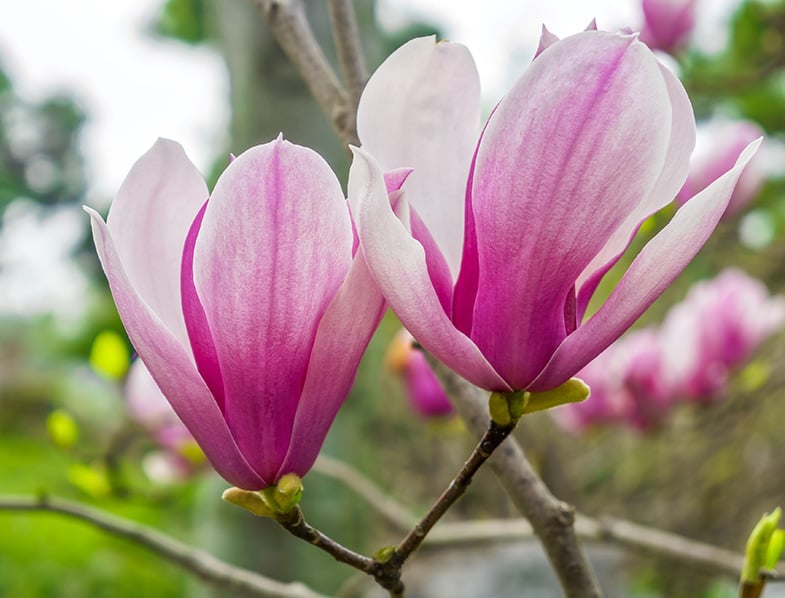
How to Plant Lily Magnolia
Planting Lily Magnolia is not a very complicated process. There are a few things to keep in mind for successful planting.
In general, it is best to plant a Lily Magnolia when it is dormant in the late fall or winter months. For the first 6 to 12 months after planting it, your shrub will benefit from mulch and regular irrigation in warmer times and dry weather.
Now, to ensure success with planting your Lily Magnolia, keep in mind the basic growing needs it has. For example, you need to remember that this shrub needs to get a lot of sunlight for at least 4-6 hours a day. So, plant your Lily Magnolia in a sunny spot.
This small tree is really sensitive to strong winds in particular and to very cold temperatures. So, plant it in a spot in your garden where it gets plenty f shelter from this type of bad weather.
Besides that, keep in mind that Lily Magnolia is sensitive to overwatering as it is prone to root rot. So, although this shrub adapts well to moist, slightly acidic soil, make sure you plant it in well-draining soil.
The lowest temperature Lily Magnolias can survive is -10 °F (-23.3 °C). So, consider if your climate is really appropriate for this shrub to thrive. More precisely, if you live in an area with a cooler climate where temperatures are constantly below freezing during winter, you should consider planting your Lily Magnolia in a container. Use a container that is several times larger than the small tree’s root ball because its roots are going to need a lot of space to grow.
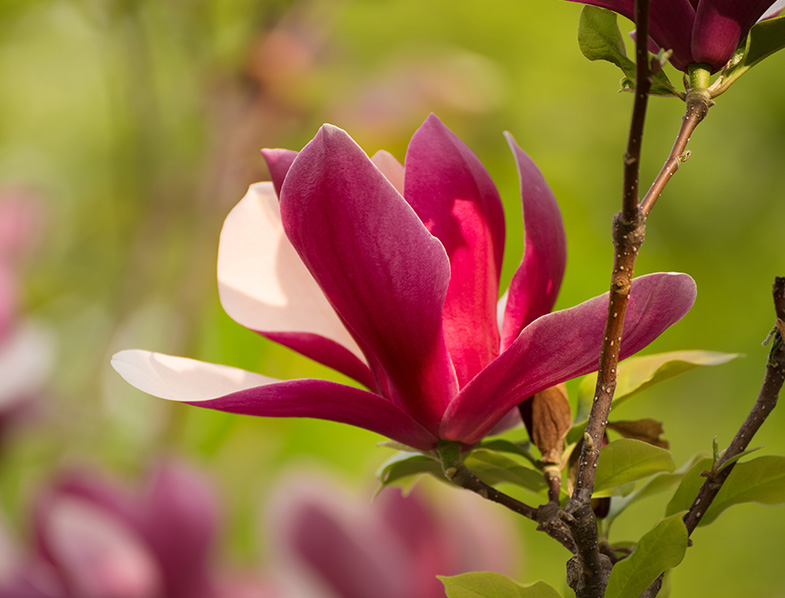
Watering Lily Magnolia
When it comes to watering your Lily Magnolia, you have to water it regularly throughout the year, especially during the first years after planting. To keep it healthy and ensure growth during its first years of life, cover your magnolia’s root area with mulch. This will help balance out soil moisture levels and temperatures.
After the shrub has established and it has completely developed its root system, it becomes relatively tolerant of temporary dry conditions. But it is a good idea to pay more attention to watering it during prolonged droughts that are more frequent in the hot summer months.
Important thing to keep in mind: Don’t forget about providing your Lily Magnolia with well-draining soil to protect it from root rot, which can be caused by overwatering.
Propagating Lily Magnolia
If you want more lovely Lily Magnolia shrubs in your garden, you can propagate your mature plant via cuttings or by planting the seeds. Seed planting will take longer until the shrub starts to grow.
Propagation via cuttings is the most popular method in the case of Lily Magnolia. To propagate your parent shrub, take 6 to 8-inch cuttings in early summer after the buds have set. It’s best to take the cuttings from growing tips of the branches of your mature Lily Magnolia. Remove the upper leaves from the cuttings and then make a 2-inch vertical slice at the end of the stem and then place it in rooting hormone. Plant the cuttings in small containers that are filled with moist perlite.
The next step is to cover the container in a loose plastic bag and place it in a bright location but where it doesn’t receive direct sunlight. Keep and grow the cuttings there for a few months until the root system has developed. Once this process is complete, you can plant your young Magnolias in your garden. It’s best to transplant your new Lily Magnolia in the garden in the fall.
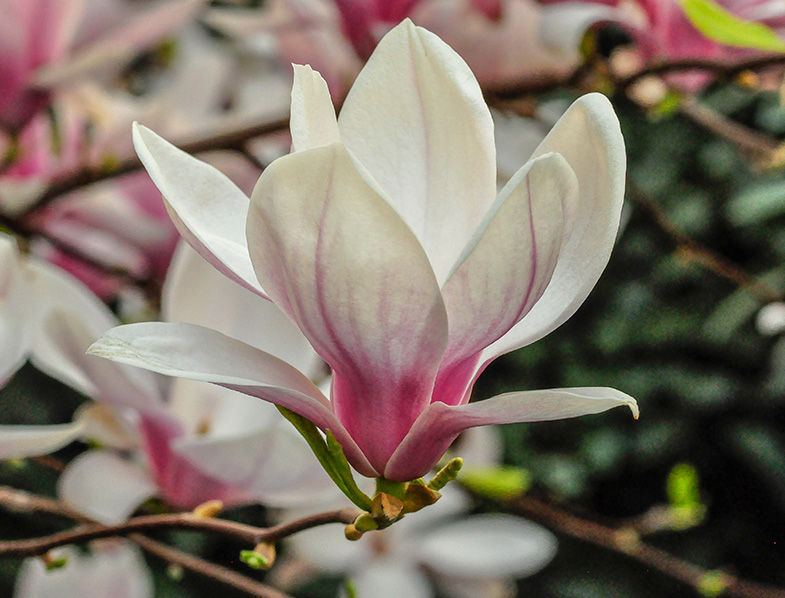
In Conclusion
Lily Magnolia is a lovely small tree to have in your garden. Its elegant appearance and delicate flowers will be an amazing focal point in your outdoor space.
Are you a fan of Lily Magnolia? Share your thoughts in the comments below!
Lily Magnolia FAQS
How fast does lily magnolia grow?
Lily Magnolia has a relatively slow growth rate. It can take up to 10-15 years for the shrub to reach maturity if grown from seed.
How do I identify a lily magnolia tree?
Lily Magnolia is identifiable by its large, dark reddish-purple, slightly fragrant, tulip-shaped flowers that bloom from early spring to summer. It also has deep lustrous green leaves and can reach heights of 8 to 12 feet (2.43- 3.65 m).
Where is lily magnolia native to?
Lily Magnolia is native to southwestern China but it has also been widely cultivated in Japan, hence sometimes being referred to as Japanese Magnolia.
What is the use of Magnolia Liliiflora?
Magnolia Liliiflora, or Lily Magnolia, is primarily used for ornamental purposes. It serves as a beautiful large shrub or small tree in gardens, offering an elegant focal point thanks to its lovely foliage and delicate flowers.
Can you eat lily magnolia?
No, Lily Magnolia is not considered edible. Although it is non-toxic and won’t cause harm if accidentally ingested, it’s not meant for consumption.
Is Magnolia Liliiflora edible?
No, Magnolia Liliiflora (Lily Magnolia) is not edible. While it is non-toxic to humans and pets, meaning it won’t cause poisoning or extreme reactions if ingested, it’s not meant to be consumed as a food source.

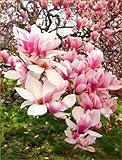

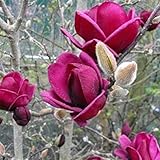
3 Comments
Wow, I found this on a google search about this tree and now I want two. Lol. I think this is the tree I saw in full bloom and stopped the truck and knocked on the door on the homeowner. I have it written somewhere. Very articulate but not big boring words I don’t understand. Thank you for you post. You are fantastic!
Thanks Miruna ….quite helpful .Just about to source one 45ltr+ .Know a good supplier ?Will be trying the big wholesalers as I’m a landsaper out Dural way and Bringelly . I should be able to find one of these beauties.
All the best
Any information on transplanting? There are several shoots coming up by the main trunk. Someone planted this beautiful tree next to the house and it will need to come down per the contractor. It is about 12’ tall. I do want to save some from it though.